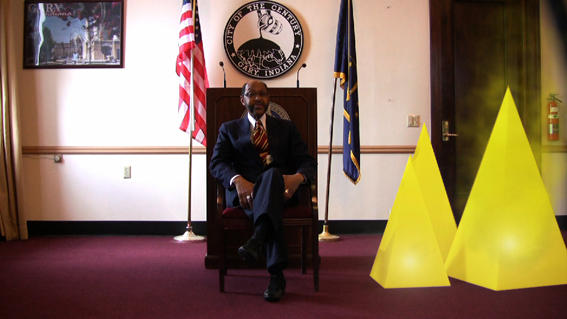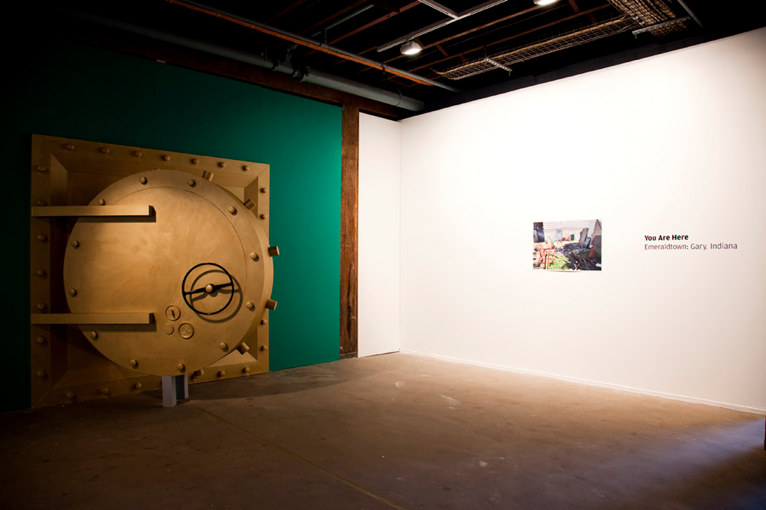Description
Emeraldtown: Gary Indiana (You Are Here), 2010
was made alongside, ReMake Estate, 2010.
Excerpt from “You are here and somewhere else” by Melanie Oliver in Column.
“Emeraldtown consisted of a documentary video and various sculptural elements. The elaborate entrance to the exhibition space, constructed to resemble a safe door made of gold, created an intimate screening space for the video projection, secluding it from the other components of the exhibition. The video did not provide extensive information for those unfamiliar with the city of Gary or its issues, nor did it provide a wider contextual background for each of You Are Here’s projects. But rather, it functioned as an entertaining and thoughtful introduction to the work, identifying some of the political issues they sought to negotiate within the series of interviews. The documentary was separated into three parts: Turning Green, with its focus on Gary and its African American population; Into the Red, which elaborated upon the context of the US steel industry and discussed the impact of the company moving to regions with non-union employment options; and lastly, Gold Standards, which elaborated upon some of the industries that remain in Gary. These section titles related to the integrated motif of the project: the 1978 film The Wiz, an adaptation of L. Frank Baum’s The Wonderful Wizard of Oz presented in the context of African American culture.
The portrait of Gary was woven together with the interspersing of short interviews with residents and segments from the The Wiz. Produced by Motown, the film featured an entirely African American cast, including Diana Ross in the role of Dorothy, offering an obvious contrast to, and critique of, race relations in American society in comparison to the Kansas depicted in the well-known 1939 version The Wonderful Wizard of Oz. Furthermore, while Baum’s book The Wonderful Wizard of Oz (1900) is usually interpreted as an American fairytale about self-confidence, there is also a theory that it was written as a parable for the debate on the introduction of the gold standard in the late-nineteenth century. The Wiz accentuates this, making a more direct and contemporary analogy to the capitalist economic structure. In light of the ongoing effects of the 2008 global financial crisis, debates around the legitimacy of such a system still remain critical today.
You Are Here employed The Wiz to connect this analogy of society with the complex history of Gary and the relationships between the mainly African American population, the US Steel Corporation and former resident Michael Jackson, teasing out the complicated post-industrial legacy of the city. This contributed elements of entertainment within the project, creating an intricate network of associations between the various characters, the fictional plot and how this representation can be interpreted through its application to the realities of the issues and challenges facing the city of Gary. Michael Jackson was identified as the Scarecrow, kind and generous but apparently lacking in brains; the US Steel Corporation was represented as the Tin Man – cold, inflexible and desperately in need of a heart; and the residents of Gary were compared to the Lion, only wanting for courage. The emerald sculptures in the exhibition space referenced those featured in the film, creating a contextual relationship, so that those watching the video might contribute their personal narratives to the collective memory.
Through its linkage to this well-known American fairytale and its various iterations, of differing perspectives and from different eras, enabled the project to speak more generally on the act of representation. By way of example, the opening sequence of The Wiz features a graffiti mural from which the Munchkin characters come to life when Dorothy unwittingly kills the Wicked Witch of the East. You Are Here’s film Emeraldtown similarly opens with a mural, in this case commissioned as part of their ReMake Estate project in Gary. Both films position the act of representation as vital, in the first example as a limiting constraint, and in the second as a form of empowerment.
The avoidance of copyright clearance for the use of segments from The Wiz was fitting, claiming popular culture as a shared community resource rather than pandering to corporate ownership, while the interviewers each shared their own views and stories with minimal editing. Given the current cult of individualism, the act of collaboration would seem to operate hand in hand with activism and alternative ways of producing knowledge. As always, You Are Here started their project from a dialogue with each other that developed into a cacophonous investigation and representation of the community of Gary, its past, present, and potential future.”
Review in Eyeline here









